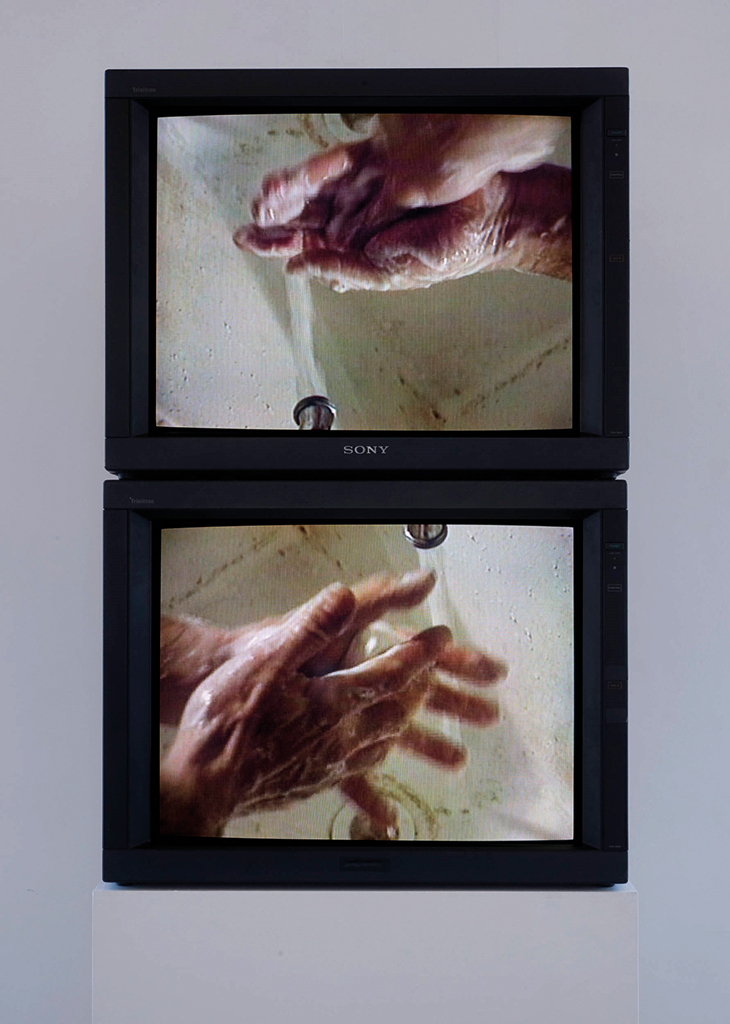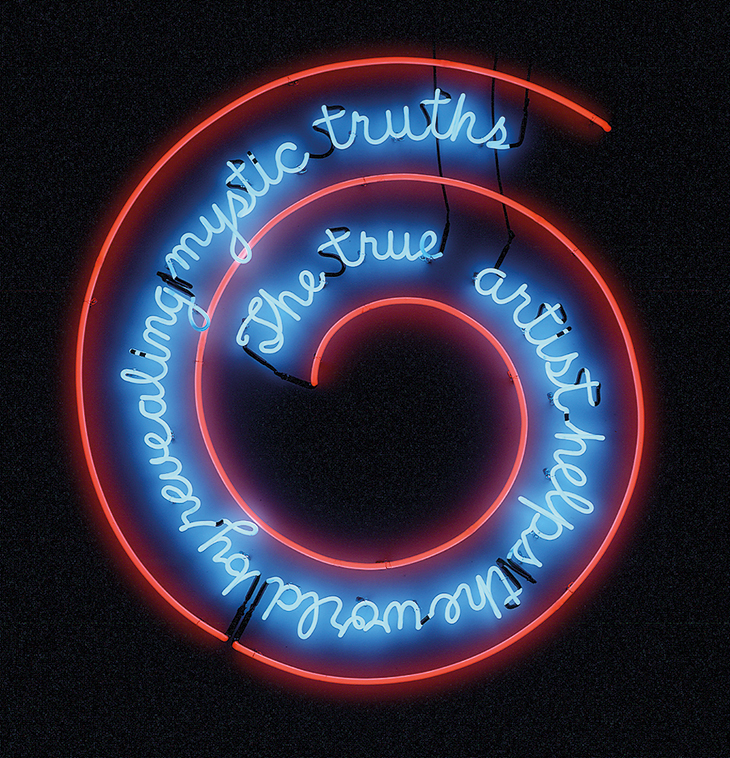Like most of us these days, Bruce Nauman is washing his hands. Never one to do things by halves, though, the venerable American artist significantly exceeds the officially prescribed two rounds of the Happy Birthday song. Fervently, repeatedly, he scrubs, lathers, rubs, again and again, paying meticulous attention to the fingertips and the gaps between his fingers. In any other year such scrupulousness might appear to border on the compulsive, a ritual taken beyond its use function to the point of perversity. But in 2020? It’s hard to say whether Tate has placed the work, titled Washing Hands Normal (1996) – a pair of stacked monitors on an endless loop – on the ground floor as part of the big retrospective exhibition three floors up, or simply as a guide for good behaviour, yet more Covid signage to join the arrows that indicate the building’s one-way system and the notices requesting we ‘please keep a safe distance’ from other visitors. Maybe, like much in Nauman’s diverse and expansive body of work, it can operate in both ways at once, performing a double duty that is modestly humdrum and obscurely poetic.
Washing Hands Normal (1996), Bruce Nauman. Tate, London, and National Galleries of Scotland © ARS, NY and DACS, London 2020

This Janus-like quality of Nauman’s work was highlighted in one of the first pieces of critical writing devoted to the artist, Fidel Danieli’s ‘The Art of Bruce Nauman’ for Artforum in 1967. Faced with a ‘debate’ as to whether ‘the artist is pure and naive or a witty and sophisticated literate’, Danieli favoured ‘an amalgam: an intellect in the service of earnest visualization and scrupulous realization’. Several works from this period are included here, all perfectly illustrative of this strange compound. Most conspicuously, the series of films he made in the late ’60s after his revelation that ‘If I was an artist and I was in the studio, then whatever I was doing in the studio must be art.’ We have Bouncing in the Corner, No. 1 (1968) in which the artist does just that, propelling his body forward and slumping back against the walls of his studio for the full 60-minute length of a video tape, and the similarly self-explanatory Walking in an Exaggerated Manner Around the Perimeter of a Square (1967–68), lasting all 10 minutes of a reel of 16mm film. In each case, the repetition of an almost inanely simple activity for the full length of its medium starts to assume an abstract, sculptural quality. The ridiculous gradually becomes sublime.
Though it has changed location several times since then, Nauman’s studio continues to exert a significant presence in the artist’s work. The show opens by immersing the viewer in the room-filling work MAPPING THE STUDIO II with color shift, flip, flop, & flip/flop (Fat Chance John Cage), from 2001. Across seven screens variously tinted pink, green, yellow and blue, we see cables strewn about, a flight case, mannequin heads, paint pots and aerosol cans – references to other works and general artist paraphernalia, all unkempt and apparently spontaneously arrayed – as cameras observe the otherwise empty space over almost six hours culled from several weeks’ worth of filming. Viewers waiting for any ‘action’ will have to be content with the occasional appearance of a mouse, darting out from a pile of junk and hurrying away again. An arrangement of four chairs in a circle in one screen, each piled high with VHS tapes and books, seems only to emphasise the absence of any human subjects. Like the notorious note-free composition 4’33’’ by this work’s dedicatee, Mapping the Studio sets its sights on demonstrating the fullness of a seemingly empty space (although my years of exposure to ‘found-footage’ horror films lend it a certain haunted quality, as if the room is awaiting a poltergeist).
Clown Torture (1987), Bruce Nauman. Art Institute of Chicago. Courtesy Sperone Westwater, New York; © Bruce Nauman/ARS, NY and DACS, London 2020

Across the half-century of work here, Nauman’s oeuvre demonstrates a remarkably consistent desire to eke out the creative potential in the most at-hand of materials: the artist’s own body and the four walls that surround it. But he has picked up a few other interests along the way, in particular such homespun popular art forms as stage magic, clowning, vaudeville and mime. This last shows up in another room-filling work, Shadow Puppets and Instructed Mime (1990), in which a blank-faced mummer responds to a series of increasingly absurd barked instructions from an unseen speaker (‘Stand up’, ‘Roll over’, ‘Put your leg on the chair’, etc.) with a panache that repeatedly exceeds the blankness of the spoken words. It’s the clowns that come in for punishment in the four-channel work Clown Torture (1987), in which they are seen variously jumping, crying, dunked on by buckets, or on the loo. It features the same sense of ritual and relentlessness as the early video works, yet the viewers now find themselves helplessly complicit – as with Shadow Puppets and Instructed Mime – in a pantomime of authoritarian rule, the ridiculousness of which cannot mask its essential cruelty.
The True Artist Helps the World by Revealing Mystic Truths (Window or Wall Sign) (1967), Bruce Nauman. Kunstmuseum Basel. Courtesy Sperone Westwater, New York; © Bruce Nauman/ARS, NY and DACS, London 2020

Tate Modern’s Nauman retrospective is a raucous, noisy affair, alive with buzzing neons, screeching violins and screaming performers. From his slovenly studio floors to the haphazard pile-ups of video monitors and rough-hewn sculptures (see A Cast of the Space Under My Chair from 1965–68) in these galleries, there is everywhere a sense of clutter and chaos. It marks out the artist as the diametric opposite of minimalist contemporaries, such as Robert Morris, Donald Judd, and Dan Flavin. But in many respects their concerns are the same: the effects of space on the body, the transformative potential of repetition, and the nature of artistic materials. Nauman’s work can easily be dismissed as simplistic or even puerile, but it can also be deeply affecting and archly conceptual. Like Danieli, I like to think it can be both things at once – and all the more powerful for it.
‘Bruce Nauman’ is at Tate Modern, London, until 21 February 2021.
From the December 2020 issue of Apollo. Preview and subscribe here.



